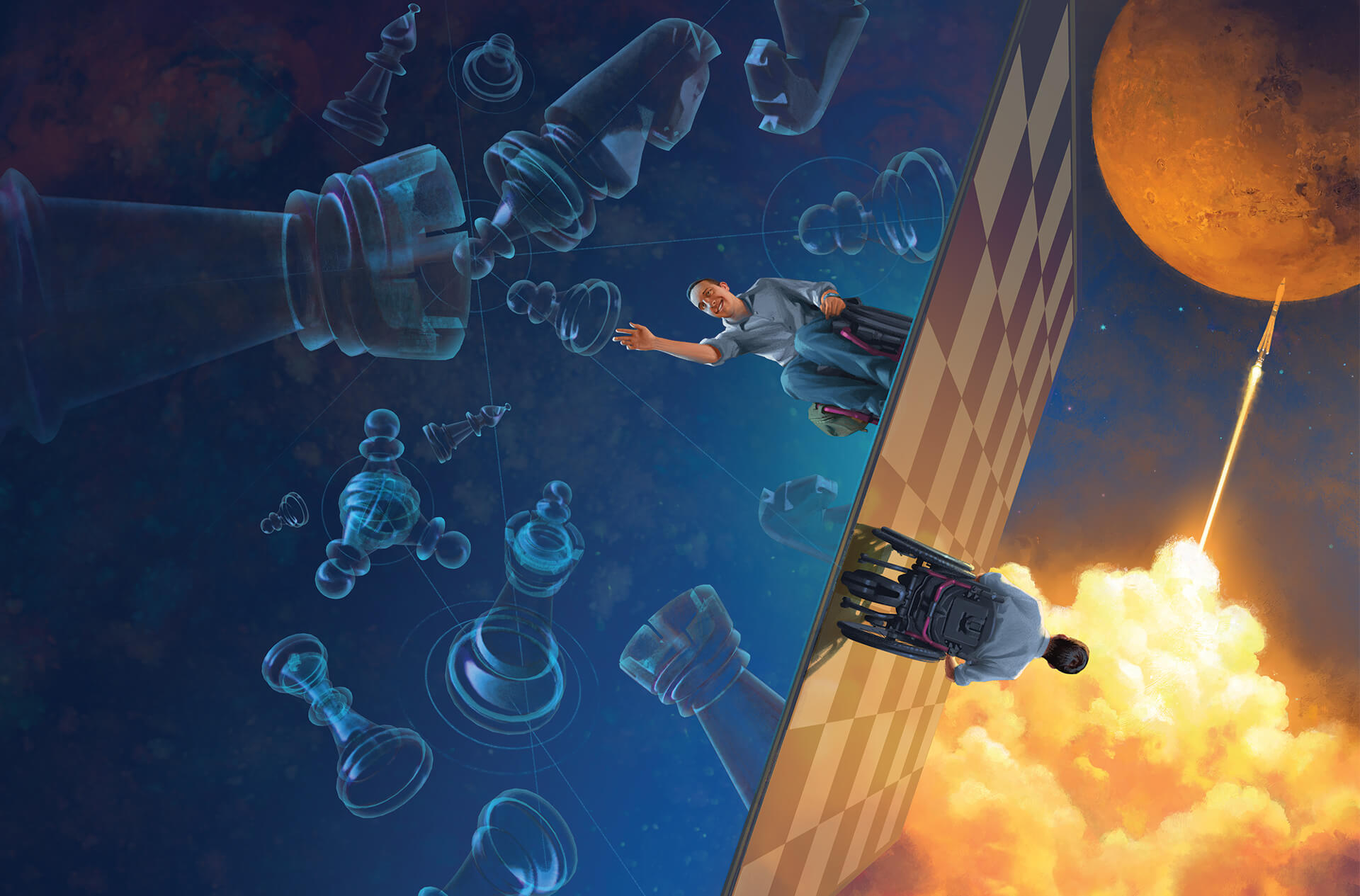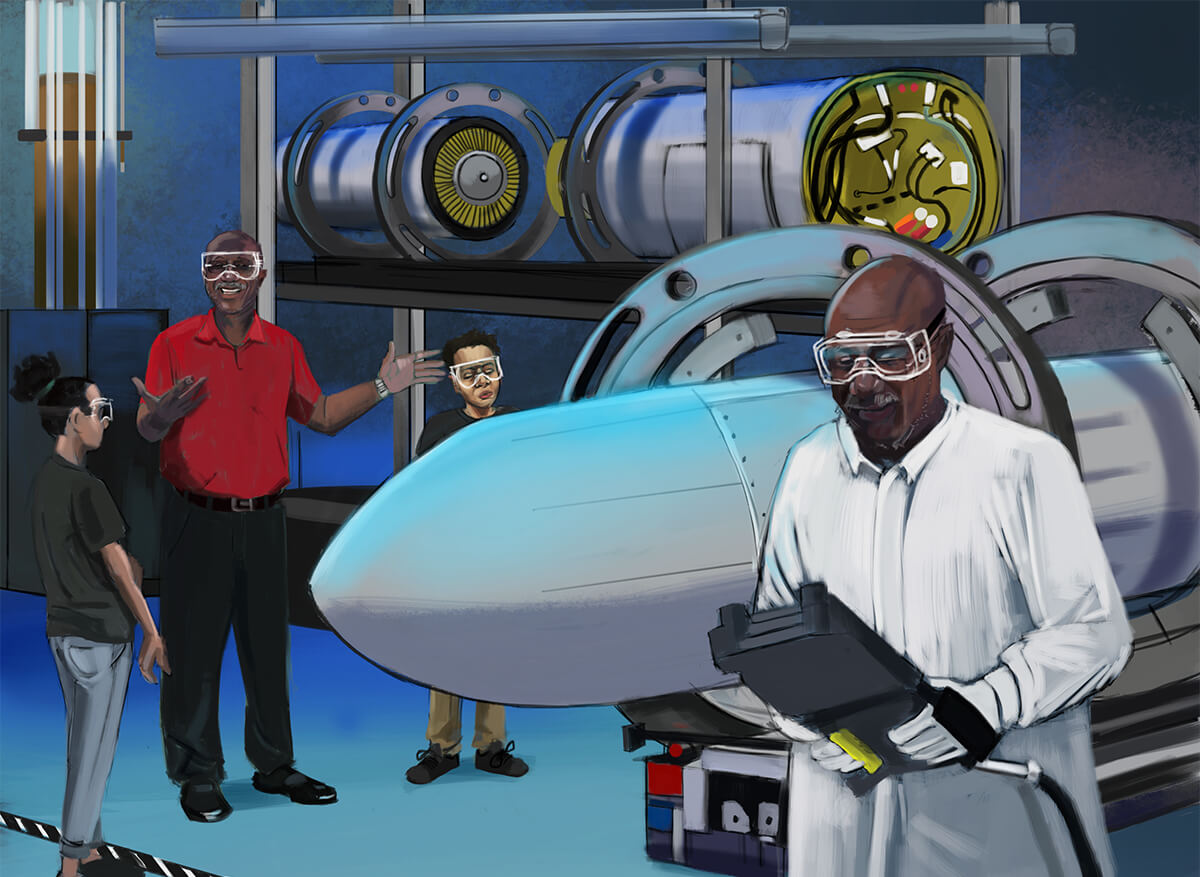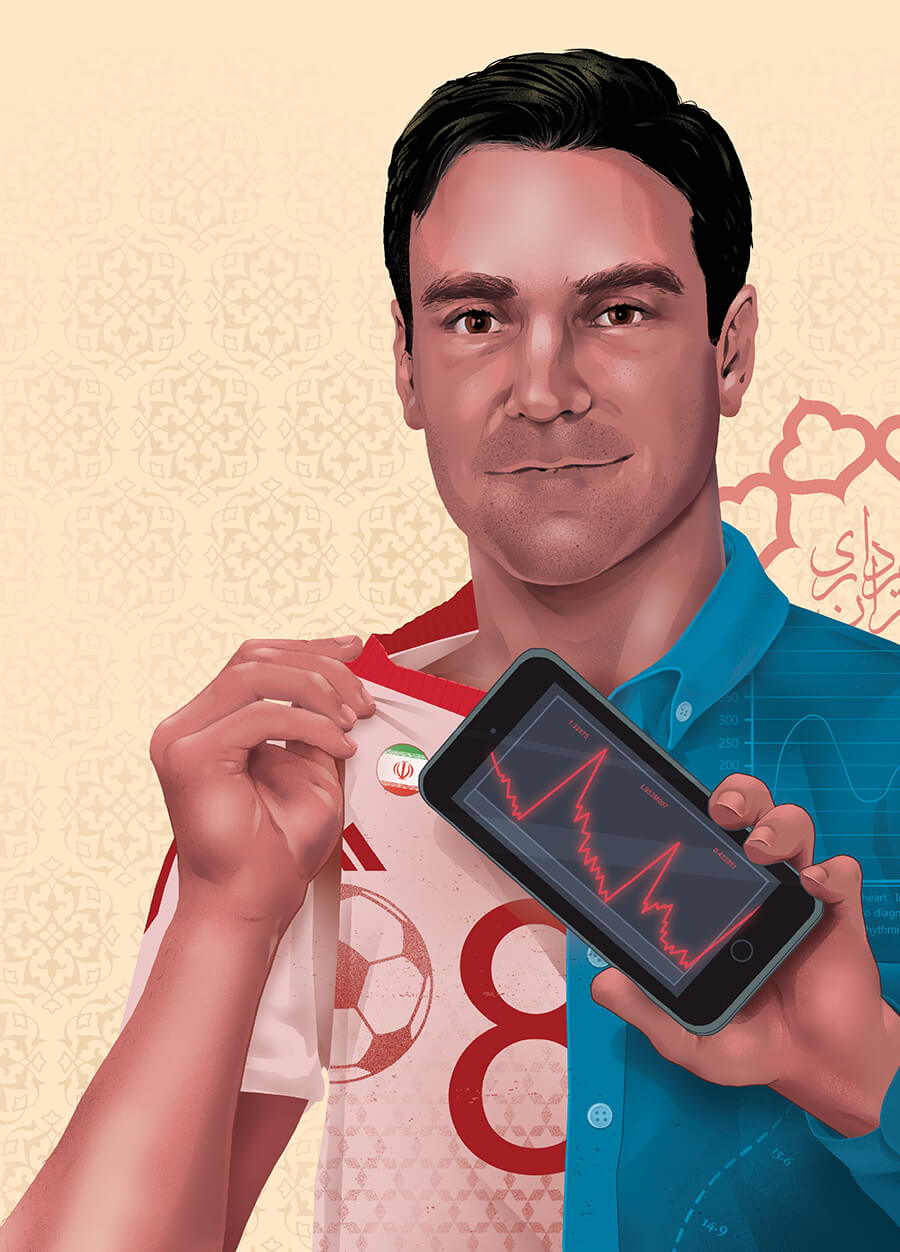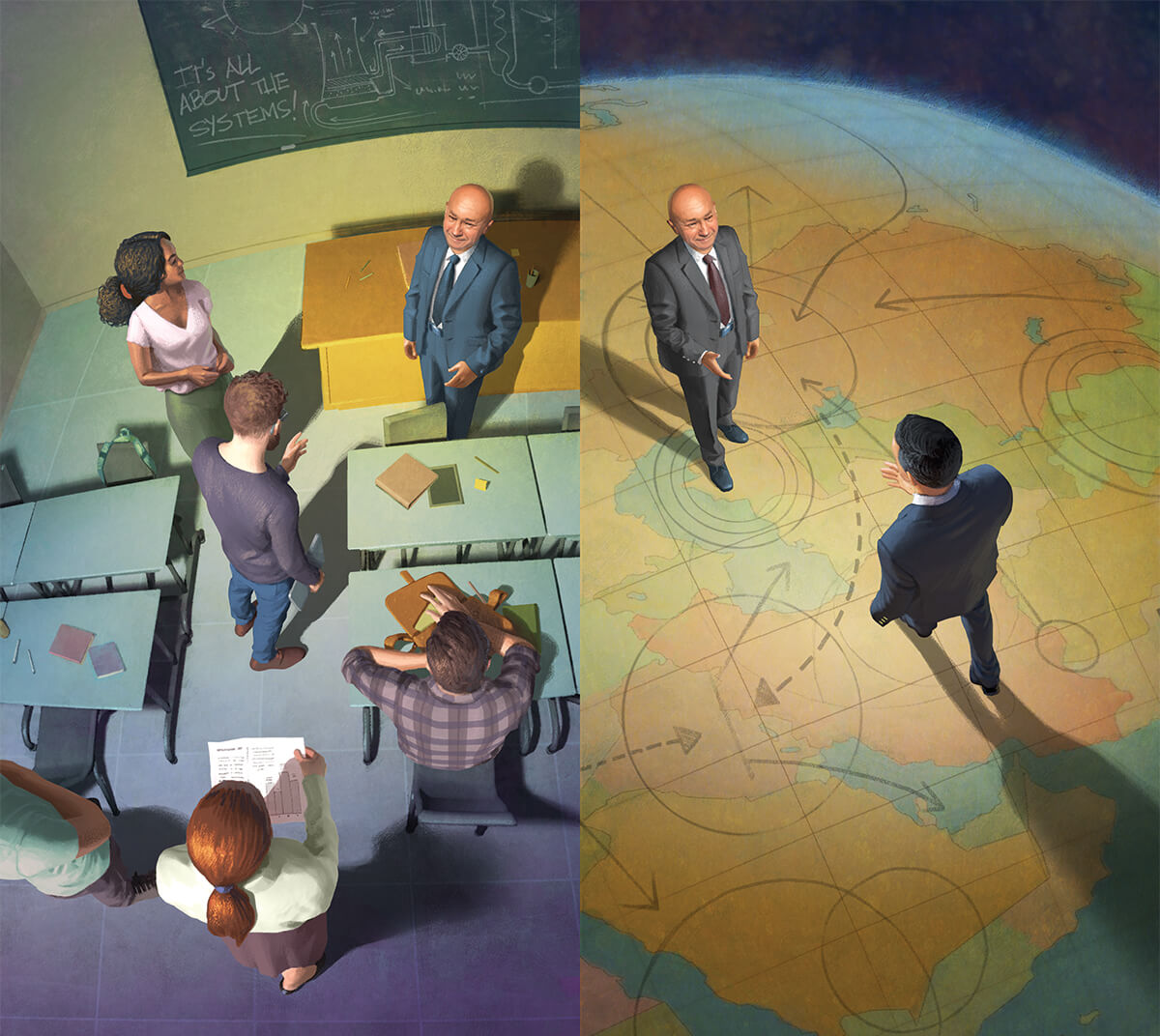Infinite Versions of Us:
The Roads Not Taken

Chris Cantwell
By Ben Paul
Known World: Quantum Games
As a master’s student in physics, Chris Cantwell loved playing games on his phone in between classes. One day he happened to run into USC Viterbi Professor Berok Khoshnevis, who encouraged Cantwell to sign up for his course on invention and creativity in engineering. Cantwell already received a USC Viterbi degree in electrical engineering in 2006, so the opportunity made a lot of sense.
Cantwell’s subsequent project for the class was a quantum game of his own invention. What started as a fun project for a graduate course credit eventually evolved into the game that is known today as Quantum Chess. Cantwell’s game has grown into a full-blown phenomenon, including the 2016 short film “Anyone Can Quantum,” starring Keanu Reeves, Paul Rudd and Stephen Hawking.
Now, as CEO and founder of his own game company, Quantum Realm Games, Cantwell has been collaborating with Google on developing the game further. In fact, the two sides recently agreed to a two-year extension to run quantum chess on Google’s quantum computing hardware.
The beauty of quantum chess is how effortlessly it familiarizes people with the concepts of quantum mechanics. For example, in the online game, players can do “quantum moves” where a queen might be in two different positions simultaneously.
“Because we don’t have everyday tools that allow us to interact with quantum mechanics, it can be intimidating for people to approach it,” said Cantwell. “When superposition — the ability of a thing to be in two places at the same time — is part of the mechanics of a fun game, it makes new concepts relatable. Suddenly this discipline seems less like magic and more like science.”
Alternate World: Space Flight for the People
But what if Chris Cantwell had never encountered Professor Khoshnevis in an empty classroom that day?
Upon completing his USC Viterbi dissertation, “Assorted Topics in Quantum Computing,” Cantwell refocuses on another passion: space exploration. Of course, in this world, he still lives in Southern California — that was a job requirement! With his Ph.D. in hand, Cantwell lands a job working for SpaceX, just down the road from USC.
As one of the company’s star software engineers, Cantwell writes a game-changing code that helps SpaceX develop the first rocket to bring humans to Mars. Cantwell’s work on flight control software is key to bringing about the next generation of space travel, eventually allowing people to travel through space in the same way we once boarded transcontinental flights.
In 2030, soon after his alternate-reality self makes Quantum Chess the first quantum training tool for school-aged children, this Chris Cantwell boards a flight with his wife and two children on one of the first commercial space flights to Jupiter’s moon Europa. Coasting above the distant moon’s icy surface, Cantwell realizes a lifelong dream and is one of the first to see the recently discovered life flourishing in Europa’s ocean below.

Tim Ellis
By Avni Shah
Known World: Building a Multiplanetary Existence with 3D Printed Rockets
As a child growing up in Plano, Texas, Tim Ellis, B.S. ’12, M.S. ’13, would spend hours building spaceships with Legos. But as he grew older, he spent more time making short films with his friends. When it came time for college, he chose USC for its proximity to Hollywood and its strong screenwriting program.
At USC, the world grew bigger, and so did Ellis’s curiosity. He met students from the USC Rocket Propulsion Laboratory and saw his first engine firing in the Mojave Desert, where the idea of changing the future of humanity through space exploration became an enduring muse. He switched majors to aerospace engineering and worked long hours at RPL to help put a student-built rocket into space.
The USC Rocket Lab is also where Ellis met Jordan Noone, with whom he started Relativity Space in 2016. Their goal: to create the world’s largest metal 3D printer to 3D print rockets that could be launched into space.
With a vision for a multiplanetary human existence, Relativity Space plans to launch its first 3D printed rocket, Terran 1, later this year.
“If we want to make human existence multiplanetary, 3D printing will be required,” Ellis explained. “Someone has to be that company, and we thought that could be us.”
In November 2020, the company closed $500 million in funding, an effort buoyed by Ellis’s penchant for strong, entertaining writing to attract investors and space enthusiasts. Indeed, his cold email to billionaire entrepreneur Mark Cuban came with a subject line right out of a Hollywood pitch: “Space is sexy: 3D printing an entire rocket.” Five minutes later, Cuban responded. He then provided their initial $500,000 in funding.
“It’s definitely true that storytelling and coming up with a compelling vision is crucial. If there were a million people living elsewhere in the universe, it would change what it means to be human,” Ellis said. “I think captivating imaginations is really important.”
Alternate World: The Filmmaker
As a teenager, Tim Ellis spent a lot of time pondering life’s existential questions — mainly, what is the true purpose of humanity, and how does it change in different contexts. Movies like “Donnie Darko” and “Requiem for a Dream” fed his appetite to look at the human condition from alternate, philosophical angles. In Los Angeles, he looks to emulate Darren Aronofsky, exploring the human condition through relationships and the bending of realities the way the director does in “The Fountain.”
Said Ellis: “I kind of like the message of humans are going to be alright and we will always find a way to save ourselves.”
At the USC School of Cinematic Arts, he works on his debut film, a screenplay about a religious man who seeks to prove, concretely, that there is indeed a God. “The character goes into a Starbucks for a highly televised event and drinks hemlock. His soul floats through purgatory and down to hell, where it has a fight with the actual devil,” Ellis said. His inspiration: the transgressive, sarcastic style of “Fight Club” author Chuck Palahniuk.
Following graduation, Ellis’s screenplay is greenlit with an indie budget of $20 million. The movie debuts at the Tribeca Film Festival, where it wins critical acclaim, and Ellis was written up by Vanity Fair as one of five new writers to watch. His follow-up film is a love story between two people who have been repopulated to Mars. It is his first big-budget feature.
Married to his college sweetheart, an artist, he remains inspired by the intersection of art and science and their grand impacts on humanity. “We’ve always thought if you made a Venn diagram of science and art, the middle section would be wonder,” he said. Wonder Productions, the name of Ellis’s production company, would work with filmmakers and artists who “challenge how people think and their broader understanding of what the purpose of humanity is and what it means to be a person in modern society.”
For Ellis, the legacy he hopes to leave behind is simple: “I got into film because I would read or watch things that would just blow my mind. A lifetime achievement for me would be able to give that same experience that others gave to me. I just want to share the excitement of what it is to be alive.”

William Wang
By Adam Smith
Known World: The Entrepreneur
William Wang, B.S. EE ’86, is the billionaire founder and CEO of Vizio, one of the most recognizable TV brands in the world. Last March saw the culmination of nearly 20 years with Vizio, as Wang took the company public on the New York Stock Exchange, ringing the bell and “have a symbolic Olympic podium moment,” he said.
But the path was not always smooth. With poor grades at USC, Wang did not follow his friends in graduate school. Instead, he took a job in customer service for a maker of computer monitors, dreaming about the future of TV.
Later, he launched multiple companies, including MAG Innovision and Princeton Graphic Systems, which, although initially successful, ended up losing around $45 million. Wang had just visited his creditors his Taiwan, in fact, to break some bad news in October 2000 when he experienced one of the great “what if” moments of his life: With a typhoon brewing off the coast, the Singapore Airlines pilot turned right instead of left on the rain-soaked runway. Halfway in the air, the Boeing 747 hit some construction equipment at 180 miles per hour, detonating 60,000 of jet fuel and killing half the passengers.
Wang survived, and all the mind-swallowing siege of his failed businesses vanished. Within two years, he had moved on to Vizio, backed by those very same creditors and aided, in part, by the $900,000 payout to survivors from the airline.
The young man, who had learned English from TV shows like “Charlie’s Angels,” was now making affordable HDTVs on a grand scale.
Alternate World: The Architect
Wang’s childhood dream was to be an architect like I.M. Pei, another Chinese American who created buildings like the iconic Louvre Pyramid in Paris: “It’s simple and modern, yet timeless.…I admired how someone would think about something and then make it into reality for many others to enjoy.”
Even in our reality, where Wang chose electrical engineering over architecture, citing the higher pay and approval of his parents, he can’t escape architecture. “I helped build a house for my parents, which was a great joy, and have built others, like in San Francisco or the one I am working on in Newport Beach,” he said. “I am having a lot of fun because it allows me to pursue my passion that gives me happiness and allows me to express my creativity.”
What if Wang had followed the path of his hero, Pei? What if his parents had encouraged him instead to become an architect? And what if the Singapore Airlines flight had never happened and the crushing debts had caused him to reevaluate his life’s trajectory?
Said Wang, “I think it would be fascinating to architect hotels, airports and other major structures that people from everywhere could experience. I would likely still infuse my love of new technology and innovation into the buildings I create. I’d probably still be living in Orange County, where the weather and amenities are great.”
Imagine, for a moment, the new Lucas Museum of Narrative Art near USC designed by William Wang — filled, of course, with state-of-the-art flat-screen TVs.

Darin Gray
By Marc Ballon
Known World: The K-12 Educator
When Darin Gray was asked if he’d be interested in leaving his comfortable job as an engineer at Hughes Aircraft to become a full-time math teacher to at-risk youth, he resisted the call. His supervisor told him it would be a terrible mistake.
But Gray saw a lot of really smart kids who had never had a good math teacher. Having grown up among troubled teens himself in Detroit, Gray felt they deserved an opportunity.
He quit his job as an engineer in 1990 – his dream since he was 16 years old – and dedicated the next 31 years to serving students as a teacher, administrator and now as co-director of USC Viterbi’s K-12 STEM Center.
As a teacher at the Metropolitan Skills Center, an alternative school in Los Angeles, Gray focused on connecting math to his students’ interests — for instance, discussing a song’s beats per minute with an aspiring rapper — making him the school’s most popular teacher. So talented was Gray — who graduated from USC in 1988 with a triple major in mathematics and biomedical and electrical engineering — that he soon taught every subject except fine arts. Under his direction, graduation at MSC rates tripled, along with the number of students going on to college.
Named the Orange County Engineering Council’s 2020 James E. Ballinger Engineer of the Year, Gray has brought that same can-do spirit to USC Viterbi, placing hundreds of Trojan engineering students in area schools as volunteer teachers and training scores of local STEM elementary school instructors.
“The impact I make in the community resonates with me,” said Gray, who continues to teach STEM summer school courses. “Teaching is my calling.”
Alternate World: The Aerospace Engineer
As a young engineer at Hughes Aircraft in El Segundo, California, in the late 1980s, Darin Gray had it all. The USC Viterbi alumnus earned $35,000 a year ($80,000 year in today’s dollars), nearly 50% more than his social worker-mother. He had distinguished himself as a rising star and loved the challenge of solving big, complex problems as an engineer.
In his first two years on the job, Gray worked on a chip that ended up on the radar system of a fighter plane, and created a software program that increased the efficiency and shortened the completion times of his team’s circuit design projects. The recipient of several raises, Gray seemed destined for greatness.
“I got called to the carpet by some of my colleagues for making them look bad by working too fast,” he said with a laugh.
In 1990, though, Gray left engineering behind and took a full-time job as a teacher at an alternative high school in Los Angeles. But what if he hadn’t? Gray believes he would have made a mark in engineering, just as he has as an educator over the past three decades.
Given his career trajectory, Gray would have probably become a senior engineer at Raytheon, which subsequently acquired his unit. He believes he would have continued to volunteer teach and, as a side gig, become a real estate broker with lots of people working for him.
“I would probably be living in Baldwin Hills instead of Whittier and driving a Lincoln instead of a Toyota,” he said.
“However, I really love where I am now, the people in my life, the folks I work with, my family, my friends, you know, the people I’ve built relationships with over the past few decades.” Gray added. “I wouldn’t trade that at all.”

Niema Pahlevan
By Avni Shah
Known World: The Mechanical Engineer Saving Hearts
Growing up in Iran, Niema Pahlevan was inspired to become a biomedical engineer at the age of 10, when his father’s cousin had a heart attack. “My dad and I went to the hospital to visit him,” Pahlevan said, “and I got to know about the idea of an artificial heart.”
He studied mechanical engineering at the University of Tehran and later earned his M.S. in mechanical engineering from California State University, Northridge.
At the California Institute of Technology, where he earned his doctoral degree in bioengineering and received his postdoctoral training in medical engineering, Pahlevan developed a smartphone-based heart monitoring device to help detect heart failure early on and to measure heart ejection fraction (a measure of heart pumping ability). He is now working on expanding the smartphone-based method to diagnose “silent” heart attacks that often go unnoticed.
“A good portion of heart failure patients are not quickly diagnosed. On top of that, if they come to the hospital or clinic, they are often discharged too early, resulting in an early rehospitalization,” Pahlevan explained.
Now at USC Viterbi, where he is an assistant professor of aerospace and mechanical engineering, he’s working to accelerate the science behind diagnosing heart attacks with the support of a three-year American Heart Association Career Development Award.
The technology works by measuring skin vibrations produced by shifts in the dynamics of blood flow. These vibrations can be measured externally, for instance, on the surface of your neck, along the carotid artery, said Pahlevan, who is also assistant professor of medicine in the Division of Cardiovascular Medicine at the Keck School of Medicine of USC.
“A diagnosis and monitoring tool that helps determine if individuals are experiencing a heart event — or if they’re on the brink of one — could save lives,” he said.
Alternate World: The Professional Soccer Player
However, even in the known world, Pahlevan had another great and abiding passion: soccer.
During his youth in Iran, he enjoyed playing street soccer with other kids in the neighborhood. At 14, his uncle, who was the captain of the Taj youth soccer club and an outstanding player himself, took him to participate in an “amateur” league. In fact, there were no youth leagues around where he was living, northeast of Tehran, at the time, so Pahlevan played with adults twice his size for much of his adolescence.
At the University of Tehran, he tried out and played for the school’s incredibly competitive soccer team. “We had one of the most invincible teams in Iran school history,” he said. “We were champions for 13 consecutive years.”
Inspired by “Doctor Socrates,” who played for the Brazilian national team and had a medical degree, Pahlevan studied mechanical engineering, furthering his interest in biomedical devices like an artificial heart. During his sophomore year, Pahlevan injured his knee when he was tackled by two defenders during a semifinal game. He had to sit out the final — which ended as the team’s first loss in a very long time.
That’s how the story ended in our world. But imagine, in an alternate Earth, if Pahlevan had unexpectedly come back faster and stronger, and in his last two years at school, he brought home two more championships. Then, as a part of a university-level national team, Pahlevan competed in Spain against teams from all over the world. A scouting coach there noticed his talent and after graduating, he joined Club Deportivo Tenerife, a second division club team in Spain.
For the next decade, he played for various clubs in Spain and France, and even wore the white and red Iranian national uniform at the 2006 World Cup. Upon retirement, he returned to his love of fundamentals, coaching youth leagues and molding the next generation of greats. “I love teaching kids 10 to 16 years old,” he said. “They are really engaged and you can mold them.”
In his free time, he continues to play soccer recreationally, competing in adult tournaments around the world.

Catherine Ricafort McCreary
By Greta Harrison
The Known World: From the Lights of Broadway to a Startup Star
Like thousands of other wide-eyed hopefuls, Catherine Ricafort McCreary, B.S. ISE ’09, was a stranger in New York, suitcase in hand, chasing the dream in the big city. Soon after, waiting on an audition line, she bumped into Broadway icon Liza Minnelli.
“That’s when I thought, This is where Broadway happens. I can rub elbows with these stars even if I’m still trying to break in,” Ricafort McCreary said.
Born in Arizona, Ricafort McCreary has been a successful Broadway actor for over 10 years. But her creative life was balanced with a passion for STEM, encouraged by her engineer father and math teacher mother.
“My mom would take me and my brother to local auditions all the time,” she said. “As long as we had finished our homework first!”
Ricafort McCreary was drawn to industrial and systems engineering at USC Viterbi. It also helped that her degree allowed her to pursue a minor in musical theater. But after graduation, with the financial downturn impacting the job market, Ricafort McCreary thought, Why not chase her New York dreams? She slept on a friend’s sofa and woke before dawn to go to auditions.
The hustle paid off. She was handpicked by her idol, actor Baayork Lee, to play Connie in “A Chorus Line,” the role Lee originated.
Ricafort McCreary booked some of the biggest shows in town, from “Mamma Mia!” and “Honeymoon in Vegas” to “SpongeBob SquarePants,” working with the likes of George Takei and Tony Danza.
But frustration with roles that poorly represented the Asian-American experience led her to pivot back to technology in 2015 and again in 2020. She now works as a software engineer at fashion startup Stitch Fix.
It was a good balance. Her startup work gave her the stability to buy a home, with flexibility to return turn to theater if great roles emerged. But the pandemic had other ideas. Right now, she’s helping other artists whose careers were paused by the pandemic find career stability as coders, through Artists Who Code, the nonprofit she founded with her husband and fellow performer, Scott McCreary. Their team has helped hundreds of people secure their first tech jobs.
The Alternative World: Taking the Lead
What would Catherine Ricafort McCreary’s life be like if she landed her dream role, and if the pandemic that devastated Broadway never happened?
Ricafort McCreary said that after moving from ensemble to supporting roles, her main bucket-list item would have been to play a principal role, with more input in originating characters.
“It was very cool to step out as an individual in ‘Honeymoon in Vegas’ and ‘SpongeBob’ and say lines and get the audience of thousands laughing,” she said.
“The next thing I wanted was to play a character that carries the whole show — from the ‘I want’ song in the beginning, and conflict in the middle, falling in love and then the fallout from that and then the resolution at the end,” she said.
Also on the cards for Ricafort McCreary would be a creative collaboration with her brother, rapper JD “Super Smack” Ricafort. After growing up performing together, she recently directed and choreographed his video, “Choose”, an experience she found inspiring.
Weaving engineering and technology into her career has always been a strong drive for Ricafort McCreary.
“It’s exciting because there are so many other multi-verses down my path,” she said. “I want to help other people navigate a really big career transition. I would love to help the corporate world reexamine the hiring process, which can close off opportunities for creative people who don’t fit the mold.”

Najmedin Meshkati
By Daniel Druhora
Known World: The Accidental Professor
In 1973, six years before the Iranian Revolution, Najmedin Meshkati was shuttling between two worlds. During the day, he was an industrial engineering student at Arya-Mehr (Sharif) University of Technology. At night, he concentrated on his real passion — international relations and political science — at the National University of Iran, carrying some 38 units per semester. There he enrolled in a course taught by Iran’s legendary diplomat and part-time professor, the late Ahmad Mirfendereski, who became Iran’s last foreign minister under the Shah, and who would have a profound influence on Meshkati’s future.
Mirfendereski engendered a new thought in Meshkati and encouraged him to fuse his academic pursuits to become an engineer-diplomat. But the winds of revolution began to stir. At the behest of his father, Nosratollah Meshkati, a widely respected archeologist and historian, Meshkati left Iran in 1976, with his two university degrees in hand, heading to the United States to enroll as an engineering graduate student at USC.
For the past 35 years, Meshkati has taught and conducted research on ergonomics, safety culture and risk reduction of complex, large-scale technological systems, including the nuclear power, aviation, refining and petrochemical industries.
As a global expert on systems engineering, human factors and safety culture, he investigated the catastrophic events at the Fukushima Daiichi Nuclear Power Plant and the Deepwater Horizon oil spill. Meshkati has also inspected many nuclear power plants around the world, including Chernobyl. He was a Jefferson Science Fellow and served as a senior science and engineering advisor to the Office of the Science and Technology Adviser of the U.S. Secretary of State. His constant pursuit of making the world safer through engineering and diplomacy brought him to Harvard University’s Belfer Center for Science and International Affairs as an associate on the Project on Managing the Atom, which conducts and disseminates policy-relevant research on nuclear weapons, nuclear energy, and nuclear non-proliferation and disarmament.
Today, Meshkati, who describes himself as an “accidental professor,” teaches diverse courses including Engineering Diplomacy and regularly appears on television networks and news outlets as an expert on safety culture and disaster prevention, achieving the dream seeded by his mentor.
Alternate World: The Diplomat
But what if Najmedin Meshkati hadn’t listened to his father, and what if the Iranian Revolution didn’t happen in 1979, and he stayed in Iran to take up Ahmad Merfendereski’s mantle?
Meshkati is propelled unto the international diplomatic scene. Rising through the ranks, he becomes ambassador to Russia and later Iran’s foreign minister. He is given the enormous task of building diplomatic relations between Iran and the world’s superpowers.
He shuttles between Washington, Moscow, Brussels and Tehran, navigating some of the most tenuous periods in Iran’s foreign policy history.
As the country’s senior global strategist, Meshkati brings his engineering mindset to the negotiating table to craft the Iran nuclear deal. He ushers an era of scientific collaboration with neighboring states that draw their lifeblood from the Persian Gulf. He designs policies that make the region safer and more sustainable. The political science department at the National University of Iran is named after him.
Meshkati goes down in history as the foreign minister that changed the face of Iranian diplomacy in the 21st century.
“I could comfortably retire, with some part-time advisory jobs and university teachings, sipping espresso and smoking cigars with friends and pontificating,” Meshkati said.
“However, I am sure that career would have deprived me of what I believe has been my most important accomplishment: My hundreds of great colleagues and loyal former students whose friendships have enriched my life during the last 35 years of being only an accidental USC professor,” he added.

Maja Matarić
By Caitlin Dawson
Real World: The Robotics Pioneer
When she was growing up in Serbia, Maja Matarić’s uncle suggested she study computer science because it was “the profession of the future.” It was prescient advice. Today, Matarić is one of the world’s top robotics experts and a pioneer in the field of socially assistive robotics, with more than 660 publications and 41,656 citations to her name.
At 16, Matarić moved from Belgrade to the United States. After earning her bachelor’s degree from the University of Kansas, she received a master’s and Ph.D. in computer science and artificial intelligence from the Massachusetts Institute of Technology. She was drawn to AI, she said, because of her interest in cognitive science and psychology.
A Chan Soon-Shiong Distinguished Professor of Computer Science, Neuroscience and Pediatrics at USC and co-director of the USC Robotics Research Lab, Matarić’s research focuses on developing robots that provide therapies and care through social interaction, especially for people with special needs. Her USC Interaction Lab has worked with children with autism, stroke patients, people with Alzheimer’s and many others.
Recently, her research group deployed in-home socially assistive robot tutors for children with autism spectrum disorder living in Los Angeles’ inner-city neighborhoods. During the monthlong engagement, the robots personalized their instruction and feedback to each child’s unique learning patterns. The team is currently studying how such robots might help adolescents and college students manage anxiety and depression.
Matarić is passionate about mentoring and empowering others, including K-12 students and teachers, women and other underrepresented groups in engineering. In 2011, she received the Presidential Mentoring Award from President Obama for helping to prepare the next generation of scientists and engineers.
Alternate World: The Artist
But what if Maja Matarić had ignored her uncle’s advice? What if she had pursued her childhood dream of being an artist?
Matarić grew up painting abstract art inspired by her native Belgrade. It’s not hard to imagine that, upon immigrating to the United States, she might have received a prestigious scholarship to the New School in New York and become a pioneer in the field of “empowerment art.” Inspired by the Guerrilla Girls, a collective devoted to fighting sexism and racism in art, her work would be noticed for its uncompromising take on social and political issues, including gender and racial equality, education and disability rights. Her deeply layered work would draw on her interest in cognitive science and human behavior, creating sprawling, immersive, multimedia digital art exhibitions that stir human emotion and inspire action.
Matarić believes contemporary art should go beyond painting and drawing, incorporating sculpture, sound, digital art and performance. Succeeding in art, she said, is all about time investment: “It’s 90% perspiration and 10,000 hours of practice are necessary.” Her children likely followed in her footsteps, some becoming renowned abstract artists in their own right. Together, they own a studio in Queens, New York, that specializes in exhibiting new artists from underrepresented groups and offers art therapy classes to children with special needs.



